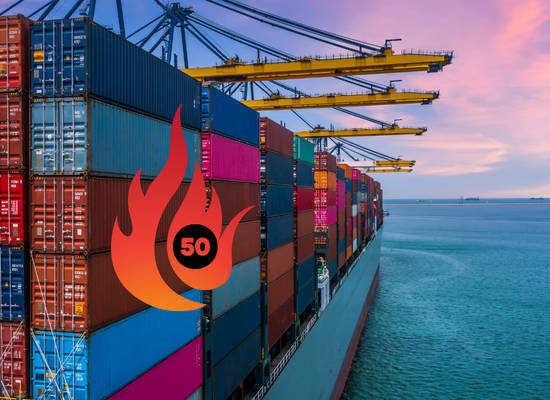50 Proven Strategies to Prevent Fires on Ships

Okay, let’s face it—implementing all 50 of these strategies would be a daunting task for any company, big or small. Keep in mind, this extensive list is designed not as a formidable checklist but as a navigational aid. It’s here to help you identify potential weak points in your fire safety protocols and offer guidance on areas that could be addressed. Each strategy, whether it’s leveraging the latest technology or fostering a culture of safety among the crew, serves as a stepping stone towards creating a safer maritime environment. Let’s get started!
* Please send feedback/suggestions to editor @ shipuniverse.com
1. Regular Maintenance and Checks
Just like you wouldn’t skip an oil change on your car, regular maintenance on your ship is non-negotiable. Ensure that all electrical systems, engines, and fuel lines are regularly inspected and maintained. A small frayed wire or a leaky fuel hose can escalate quickly into a major fire. Implement a stringent maintenance schedule and stick to it.
2. Proper Storage of Flammable Materials
Think of your ship as a giant moving storage unit. How you pack it matters. Store flammable materials away from ignition sources and ensure they are properly labeled and contained. This includes everything from fuels and solvents to everyday items like cleaning supplies. A well-organized storage area not only reduces the risk of fire but also makes it easier to manage in case of an emergency.
3. Training Crew on Fire Safety
Your crew is your first line of defense against fires. Regular training sessions on fire safety practices, use of firefighting equipment, and emergency response procedures can make a significant difference. Ensure every crew member knows their role in a fire emergency and practices it regularly through drills. Remember, a well-trained crew is a safe crew.
4. Installing and Maintaining Fire Detection and Suppression Systems
Modern ships are equipped with sophisticated fire detection and suppression systems. These include smoke detectors, heat sensors, and automatic sprinkler systems. Regularly check these systems to ensure they are in working order and conduct drills to familiarize your crew with their operation. Quick detection and suppression can mean the difference between a minor incident and a major disaster.
5. Limiting Use of Open Flames and Heating Elements
Minimize the use of open flames and portable heating elements on board. If necessary, designate specific areas for their use and ensure they are monitored. Simple rules like not leaving cooking unattended or restricting smoking areas can drastically reduce the risk of accidental fires.
6. Conduct Regular Fire Drills
Simulate real-life scenarios with regular fire drills that involve all crew members. These drills should cover different types of fire situations, including those in engine rooms, cargo areas, and living quarters. Make sure everyone knows how to evacuate safely, where to muster, and how to use firefighting equipment. Drills reinforce training and can highlight areas for improvement.
7. Ensure Proper Ventilation Systems
Adequate ventilation is crucial, especially in areas prone to accumulating flammable gases or vapors. Regular checks and maintenance of ventilation systems can prevent the build-up of hazardous atmospheres that could ignite with a single spark. Make sure that areas like the engine room, paint lockers, and cargo holds have effective and functioning ventilation.
8. Implement Strict Housekeeping Practices
Good housekeeping is often overlooked as a fire prevention measure, but clutter can significantly increase fire risks. Ensure that workspaces and living areas are kept clean and tidy. Reduce the accumulation of combustible materials like rags, cardboard, and paper, which can easily fuel a fire. A clean ship is a safer ship.
9. Use Intrinsically Safe (IS) Equipment
In areas where the atmosphere may contain flammable gases or vapors, use intrinsically safe (IS) equipment designed not to produce sparks or heat that could ignite an explosive atmosphere. This includes tools, lighting, and electronic devices. Investing in IS equipment can be a crucial preventative measure in minimizing fire risks.
10. Inspect and Control Hot Work
Hot work, such as welding, cutting, or any operation that produces sparks or heat, is a common fire hazard on ships. Implement a permit system for hot work that includes a thorough inspection of the area before, during, and after the work is completed. Ensure that flammable materials are removed or protected and that a fire watch is in place to monitor for any signs of fire.
11. Regular Inspection of Fire Doors and Escape Routes
Fire doors play a critical role in preventing the spread of fire and smoke between compartments on a ship. Regularly inspect these doors to ensure they are in good working order and free from obstructions. Similarly, escape routes must be clearly marked and kept clear at all times. This ensures that in the event of a fire, everyone on board can quickly and safely evacuate.
12. Proper Management of Electrical Equipment
Electrical fires are among the most common types of fires on ships, often due to faulty or overloaded electrical equipment. Ensure that all electrical installations are up to marine standards and that inspections are conducted regularly. Encourage crew members to report any signs of faulty equipment, and make sure that repairs are carried out promptly by qualified personnel.
13. Safe Handling and Storage of Hazardous Materials
Hazardous materials, including chemicals and gases, require special attention to prevent fires. Store these materials in designated areas away from living quarters and operational spaces, ideally in containers or rooms with appropriate fire suppression systems. Regular training on the safe handling of these materials can also prevent accidents before they happen.
14. Implementation of Smoking Policies
Smoking is a leading cause of fires on ships due to the risk of unattended cigarettes igniting flammable materials. Implement and strictly enforce smoking policies on board. Designate specific smoking areas away from hazardous and flammable materials, and provide safe disposal containers for cigarette butts to prevent smoldering fires.
15. Use of Fire Retardant Materials in Construction
When possible, use fire retardant materials in the construction and refurbishment of ship interiors. These materials can significantly slow the spread of fire, giving crew members more time to extinguish the blaze before it escalates. From wall coverings to furniture and beyond, choosing the right materials can make a substantial difference in fire safety.
16. Implement a Comprehensive Risk Assessment Program
Regular risk assessments can identify potential fire hazards before they become a problem. This should involve a thorough examination of all ship operations, storage areas, and living quarters. Identifying risks early allows for the implementation of preventive measures, reducing the likelihood of a fire starting.
17. Encourage a Culture of Safety Among Crew Members
A safety-first culture is crucial in preventing fires on ships. Encourage open communication among crew members about potential hazards and make it easy for them to report safety concerns without fear of repercussions. Regular safety meetings and discussions can help reinforce the importance of vigilance and proactive behavior in fire prevention.
18. Regularly Test Emergency Communication Systems
In the event of a fire, effective communication is key to a successful evacuation and response. Regular testing of emergency communication systems ensures that in the event of a fire, messages can be clearly transmitted and received throughout the ship. This includes alarms, public address systems, and handheld radios.
19. Keep Up With Fire Safety Regulations and Training
Fire safety regulations evolve, and keeping abreast of these changes is essential. Ensure that your ship complies with all international and local fire safety regulations. Additionally, invest in ongoing training for your crew. This training should not only cover the basics of fire prevention but also include updates on new fire safety technologies, equipment, and best practices.
20. Regular Inspection and Testing of Fire Fighting Equipment
Fire fighting equipment, such as extinguishers, hoses, and breathing apparatus, must be in optimal condition to be effective. Conduct regular inspections and maintenance to ensure that all equipment is ready for use at a moment’s notice. This also includes ensuring that all crew members are trained on how to use the equipment properly.
21. Utilize Fire Detection Technology to Its Full Potential
Advanced fire detection systems can provide early warnings that are crucial in preventing small incidents from becoming full-blown disasters. Ensure your ship is equipped with state-of-the-art smoke detectors, heat sensors, and gas detectors that are regularly maintained. Consider integrating these systems into a central monitoring system for quicker response times.
22. Practice Environmental Awareness
Be conscious of the environmental conditions that could affect fire safety on your ship. High temperatures, humidity, and sea conditions can all influence fire risk. Adjust your fire prevention strategies accordingly, especially when navigating through areas with extreme weather conditions or when carrying cargo that might be sensitive to these factors.
23. Ensure Adequate First Aid and Medical Preparedness for Burn Injuries
In the unfortunate event of a fire, being prepared to treat burn injuries on board is critical. Ensure your ship’s medical kit is stocked with the necessary supplies to treat burns, and that there are crew members trained in administering first aid for such injuries. Regular training sessions on medical response to fire-related injuries can make a significant difference in outcomes.
24. Conduct Regular Safety Audits
Safety audits are a comprehensive way to assess the effectiveness of your fire safety measures. Conduct these audits regularly to identify any areas of improvement or non-compliance with safety standards. These audits can include inspections of fire safety equipment, emergency response drills, and crew training records. Utilizing external auditors can also provide an unbiased view of your ship’s fire safety status.
25. Leverage Technology for Fire Safety Training
Utilizing virtual reality (VR) and other technological tools can take your fire safety training to the next level. These tools can simulate fire scenarios that are too dangerous to reproduce in real life, providing crew members with valuable experience in navigating fires on board. This hands-on approach to training can improve reaction times and decision-making in actual fire situations.
26. Strengthen Coordination During Emergency Response
Effective fire management requires seamless coordination among the crew. Use simulation training to create scenarios where crew members must work together to manage a fire, including coordination with emergency response teams ashore if available. This helps in identifying any gaps in communication and response strategies, ensuring a well-orchestrated effort during real emergencies.
27. Update and Upgrade Fire Suppression Systems
Technology in fire suppression is constantly advancing. Stay updated with the latest developments and consider upgrading existing systems to more effective solutions, such as water mist systems for quicker fire suppression with minimal water damage, or foam systems for fuel and oil fires. Regularly consulting with fire safety experts can provide insights into beneficial upgrades for your vessel.
28. Optimize Layouts to Minimize Fire Risks
The design and layout of ship compartments can significantly impact fire safety. Evaluate the arrangement of machinery, storage areas, and living quarters to minimize fire risks. This includes considering the ventilation systems, the proximity of flammable materials to heat sources, and ensuring that escape routes are clear and accessible. Sometimes, small changes in layout can have a significant impact on reducing fire hazards.
29. Monitor and Control the Ship’s Electrical Load
Overloaded electrical systems are a common cause of ship fires. Implement systems to monitor and control the electrical load continuously, ensuring that it does not exceed safe limits. Regularly check for and repair any damaged wiring, and replace electrical components that show signs of wear or are near the end of their service life.
30. Foster a Culture of Continuous Improvement
Finally, cultivating a culture of continuous improvement in fire safety practices is essential. Encourage feedback from crew members on fire safety measures and drills. Be open to adopting new ideas and technologies that can enhance safety. Regularly review and update fire safety policies and procedures to reflect lessons learned from drills, actual incidents, and advancements in fire safety technology.
31. Integrate Fire Safety into Maintenance Routines
Include fire safety checks as a fundamental part of your ship’s regular maintenance routine. This means not just checking fire fighting equipment, but also inspecting areas prone to fire risks, such as the engine room, kitchens, and electrical panels, for signs of wear and tear or potential hazards. Regular cleaning to remove oil, grease, and other flammable substances from these areas can significantly reduce the risk of fire.
32. Leverage IoT for Real-Time Monitoring
The Internet of Things (IoT) offers new possibilities for monitoring shipboard conditions in real time, allowing for immediate action to prevent fires. Sensors can detect abnormal temperatures, leaks of flammable substances, or malfunctions in electrical systems, alerting the crew to issues before they lead to a fire. Incorporating IoT technology into your ship’s safety systems can provide an additional layer of protection.
33. Develop Comprehensive Contingency Plans
While prevention is the primary goal, being prepared for the worst-case scenario is equally important. Develop and regularly update comprehensive contingency plans for fire emergencies. These plans should include not only evacuation procedures and roles for each crew member but also strategies for containing and extinguishing fires, protecting sensitive cargo, and coordinating with rescue services if necessary.
34. Promote Mental Health and Well-Being
The stress and fatigue associated with long voyages can impair judgment and reaction times, potentially leading to accidents that could cause fires. Promoting the mental health and well-being of your crew is a vital part of fire safety. Ensure that crew members have access to support and resources to manage stress, and encourage regular breaks and rest periods to prevent fatigue.
35. Engage in International Collaboration and Learning
Fire safety challenges and innovations are not confined to a single ship or company. Engaging in international collaboration and learning can provide insights into effective fire safety practices used around the world. Participate in forums, workshops, and conferences on maritime safety. Share experiences and learn from the incidents and solutions of others in the industry. This global perspective can help identify potential improvements in your own fire safety practices.
36. Adopt Advanced Fire Detection Technologies
Embrace the latest advancements in fire detection technology, such as infrared and ultraviolet detectors, which can identify fires in their incipient stage before they become a larger threat. These systems can be particularly effective in areas where traditional smoke detectors may not perform optimally, such as engine rooms with high levels of airborne particulates.
37. Ensure Comprehensive Insurance Coverage
While not a prevention measure per se, having comprehensive insurance coverage for fire-related incidents is crucial. It not only provides financial protection but also encourages ship owners to maintain high safety standards to meet insurance requirements. Work closely with insurance providers to understand the specific safety measures that can lower premiums and enhance coverage.
38. Foster Peer Reviews and Safety Audits
Implement a system where safety practices and fire prevention measures are regularly reviewed by peers from within or outside the organization. This can lead to the identification of overlooked risks and the sharing of best practices. Peer reviews and external safety audits bring fresh perspectives to existing safety protocols, highlighting areas for improvement.
39. Invest in Fire Resistant Materials for Ship Construction
When building or refurbishing vessels, invest in materials that are fire resistant. This includes using non-combustible materials for bulkheads, decks, and overheads, as well as choosing furnishings and finishes that minimize fire risks. While the initial cost may be higher, the long-term benefits of enhanced fire safety and potentially lower insurance costs are significant.
40. Promote Environmental Responsibility to Prevent Fires
Environmental responsibility goes hand in hand with fire prevention. Proper disposal of hazardous waste, careful handling of flammable substances, and adherence to regulations designed to protect the marine environment can also reduce fire risks. Educating the crew about the environmental aspects of their actions encourages responsible behavior that supports both safety and sustainability.
41. Leverage Data Analytics for Predictive Maintenance
Utilize data analytics to predict and prevent equipment failures that could lead to fires. By analyzing historical maintenance data and real-time inputs from onboard sensors, ship operators can identify patterns that precede equipment malfunctions. Predictive maintenance allows for timely interventions, reducing the likelihood of fire-causing incidents related to equipment failure.
42. Establish a Zero-Tolerance Policy for Safety Violations
Implement and enforce a zero-tolerance policy towards safety violations that could lead to fires. This includes non-compliance with smoking regulations, improper handling of flammable materials, and bypassing safety protocols. Such a policy underscores the seriousness with which the organization views fire safety and helps cultivate a culture of responsibility and vigilance among the crew.
43. Conduct Scenario-Based Training Simulations
Beyond standard fire safety drills, engage the crew in scenario-based training simulations that cover a wide range of potential fire situations. These simulations should include realistic variables such as equipment failures, communication breakdowns, and adverse weather conditions. This approach helps prepare the crew for unexpected challenges and enhances their problem-solving skills under pressure.
44. Implement Smart Ship Technologies
Adopt smart ship technologies that integrate various systems onboard to enhance overall safety. These systems can monitor the ship’s condition in real time, manage energy consumption to prevent overload, and even automate certain responses to fire alarms, such as shutting down ventilation systems to starve fires of oxygen. Smart technologies not only contribute to fire prevention but also facilitate a more efficient and safe operation overall.
45. Foster Partnerships for Safety Innovation
Cultivate partnerships with industry peers, regulatory bodies, and technology providers to stay at the forefront of safety innovation. Collaborating on safety research projects, participating in joint training programs, and sharing best practices can lead to breakthroughs in fire safety technology and protocols. Such partnerships enrich the entire maritime community’s knowledge and effectiveness in preventing and managing fires.
46. Enhance Fire Detection through AI and Machine Learning
Incorporate artificial intelligence (AI) and machine learning algorithms to analyze data from various sensors around the ship, improving the accuracy and speed of fire detection. These technologies can identify patterns indicating a high risk of fire before traditional systems would trigger an alarm, allowing for preemptive action.
47. Strengthen Global and Local Regulatory Compliance
Stay updated and fully compliant with both global maritime safety regulations, such as those enforced by the International Maritime Organization (IMO), and local regulations applicable to your vessel’s operating regions. Compliance ensures that your ship meets or exceeds the minimum safety standards for fire prevention, equipment, and crew training.
48. Invest in Environmentally Friendly Fire Suppression Systems
As the maritime industry moves towards greater environmental responsibility, investing in fire suppression systems that minimize ecological impact is crucial. Systems that use water mist, clean agents, or other environmentally friendly suppressants not only effectively combat fires but also protect marine life and the environment from harmful chemicals.
49. Create a Fire Safety Community Onboard
Encourage the creation of a fire safety community amongst the crew, where members actively share insights, experiences, and lessons learned regarding fire prevention and safety. This community can lead initiatives, organize educational sessions, and serve as a platform for mentoring and supporting new crew members in adopting best fire safety practices.
50. Regularly Review and Update Fire Safety Policies
Fire safety is a dynamic field, with new technologies, regulations, and practices continually emerging. Regularly review and update your ship’s fire safety policies to reflect these changes. Engage with fire safety experts, attend industry conferences, and participate in workshops to stay informed about the latest developments and incorporate them into your safety protocols.
Remember, the goal isn’t to overhaul your safety protocols overnight but to gradually integrate practices that shore up your defenses against fire risks. With commitment, collaboration, and a keen eye on the horizon for emerging safety innovations, your vessel can not only weather the storm of fire risks but sail towards a horizon of safety and security.

Do you have a Maritime Product or Service that may be of interest to Shipowners? Tell us about it here!
Do you have feedback or insights? Please reach out to editor @ shipuniverse.com



